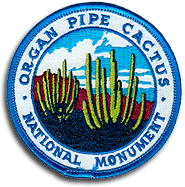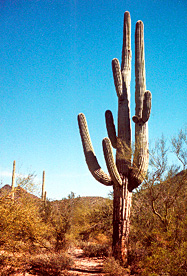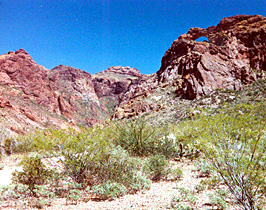|
 Organ Pipe Cactus National Monument is in the heart of the Sonoran Desert. The Sonoran Desert is unique among deserts in North America because it has two distinct rainy seasons; a gentle rainy winter season and the typical monsoonal rains that appear as cloudbursts in the hot late summers that spawn so many flash floods. Organ Pipe Cactus National Monument is in the heart of the Sonoran Desert. The Sonoran Desert is unique among deserts in North America because it has two distinct rainy seasons; a gentle rainy winter season and the typical monsoonal rains that appear as cloudbursts in the hot late summers that spawn so many flash floods.  Because of these two distinct rainy seasons, there is an abundant amount of life and greenery at Organ Pipe Cactus National Monument. It is here that several species reach the limit of their range, amongst those being the organ pipe cactus. Farther north, it gets too cold at night in winter for the organ pipe cactus to survive. Even in the monument, it is confined to the sunnier south facing rocky slopes, or bajadas, where the temperatures will not fall down to frost levels at all. Because of these two distinct rainy seasons, there is an abundant amount of life and greenery at Organ Pipe Cactus National Monument. It is here that several species reach the limit of their range, amongst those being the organ pipe cactus. Farther north, it gets too cold at night in winter for the organ pipe cactus to survive. Even in the monument, it is confined to the sunnier south facing rocky slopes, or bajadas, where the temperatures will not fall down to frost levels at all.
Most of the area that the typical visitor sees is in a mixed cactus/Palo verde type desert. There are several species of cactus that are evident in monument. While on several hikes, we noticed the Palo Verde tree in full bloom of beautiful yellow color and the the ocotillo which was also in bloom. The ocotillo is a very interesting plant that when given sufficient moisture, it sprouts leaves. When it gets hot, or there is a lack of moisture, it drops these leaves and goes dormant. There had been a major rain storm go through the area in early March, about a month before we got to the monument, so the ocotillo were in full splendor, being tipped with orange to red blossoms on all of the stalks. There is an ocotillo left of center in the picture below, but not close enough or old enough, I guess, to be in bloom.
 You can also see the namesake of the park, the organ pipe cactus to the right. These cactus would get over twenty feet tall under good growing conditions. They produce a flower that only blooms at night and so is pollinated by bats. Another species of cactus that is also pollinated by is the stately saguaro cactus. These cactus grow all over Arizona and are found in abundance here in the monument. Their blooms open at night, but unlike the organ pipe cactus, they don't close at dawn, but stay open to take advantage of white winged doves that inhabit the area for additional pollination. The saguaro stands tall in the desert, and I understand the antenna decorations that have a saguaro cactus wearing a cowboy hat. The arms of the saguaro resemble arms of human beings and they look like sentinals standing watch over the desert. This particular saguaro shown in the above picture at right was found right along the Desert View Trail. Other cactus found in the monument were prickly pear cactus, barrel cactus, teddy bear cholla, chain fruit cholla, and buckhorn cholla. You can also see the namesake of the park, the organ pipe cactus to the right. These cactus would get over twenty feet tall under good growing conditions. They produce a flower that only blooms at night and so is pollinated by bats. Another species of cactus that is also pollinated by is the stately saguaro cactus. These cactus grow all over Arizona and are found in abundance here in the monument. Their blooms open at night, but unlike the organ pipe cactus, they don't close at dawn, but stay open to take advantage of white winged doves that inhabit the area for additional pollination. The saguaro stands tall in the desert, and I understand the antenna decorations that have a saguaro cactus wearing a cowboy hat. The arms of the saguaro resemble arms of human beings and they look like sentinals standing watch over the desert. This particular saguaro shown in the above picture at right was found right along the Desert View Trail. Other cactus found in the monument were prickly pear cactus, barrel cactus, teddy bear cholla, chain fruit cholla, and buckhorn cholla.
 One of the first things we did the following morning was to take the Desert View Trail. Located at the group campground, this particular trail is one of the best in the monument for viewing the Sonoran Desert. It winds back through some small hills and ravines, around organ pipe cactus, saguaro and multitude of other types of desert flora. There were beautiful views of the Puerto Blanco Mountains to the south and down into Mexico. One of the first things we did the following morning was to take the Desert View Trail. Located at the group campground, this particular trail is one of the best in the monument for viewing the Sonoran Desert. It winds back through some small hills and ravines, around organ pipe cactus, saguaro and multitude of other types of desert flora. There were beautiful views of the Puerto Blanco Mountains to the south and down into Mexico.
We also drove the Ajo Mountain Drive. This is a graded gravel road of 21 miles that went through even more scenic views of the monumnet. There were interpretive signs along the drive that we stopped at to read from a booklet that we had purchased at the visitors center. We stopped at Arch Canyon and got a great view of the Arch in the mountain. If you look closely, you can actually see a smaller arch above the main arch. The drive was a wonderful drive to the point that we chose to drive it again a second time the next day, foregoing the longer 52 mile long Puerto Blanco Drive, which was also on a graded gravel road. It would have been too much jarring to the bones to do that long of a drive.
Comments about this page, as always, are welcome. Just sign the guestbook to give me a message.
Next national park site.
Back to the National Park Page.
Information about camping here.

|

 Organ Pipe Cactus National Monument is in the heart of the Sonoran Desert. The Sonoran Desert is unique among deserts in North America because it has two distinct rainy seasons; a gentle rainy winter season and the typical monsoonal rains that appear as cloudbursts in the hot late summers that spawn so many flash floods.
Organ Pipe Cactus National Monument is in the heart of the Sonoran Desert. The Sonoran Desert is unique among deserts in North America because it has two distinct rainy seasons; a gentle rainy winter season and the typical monsoonal rains that appear as cloudbursts in the hot late summers that spawn so many flash floods.  Because of these two distinct rainy seasons, there is an abundant amount of life and greenery at Organ Pipe Cactus National Monument. It is here that several species reach the limit of their range, amongst those being the organ pipe cactus. Farther north, it gets too cold at night in winter for the organ pipe cactus to survive. Even in the monument, it is confined to the sunnier south facing rocky slopes, or bajadas, where the temperatures will not fall down to frost levels at all.
Because of these two distinct rainy seasons, there is an abundant amount of life and greenery at Organ Pipe Cactus National Monument. It is here that several species reach the limit of their range, amongst those being the organ pipe cactus. Farther north, it gets too cold at night in winter for the organ pipe cactus to survive. Even in the monument, it is confined to the sunnier south facing rocky slopes, or bajadas, where the temperatures will not fall down to frost levels at all. You can also see the namesake of the park, the organ pipe cactus to the right. These cactus would get over twenty feet tall under good growing conditions. They produce a flower that only blooms at night and so is pollinated by bats. Another species of cactus that is also pollinated by is the stately saguaro cactus. These cactus grow all over Arizona and are found in abundance here in the monument. Their blooms open at night, but unlike the organ pipe cactus, they don't close at dawn, but stay open to take advantage of white winged doves that inhabit the area for additional pollination. The saguaro stands tall in the desert, and I understand the antenna decorations that have a saguaro cactus wearing a cowboy hat. The arms of the saguaro resemble arms of human beings and they look like sentinals standing watch over the desert. This particular saguaro shown in the above picture at right was found right along the Desert View Trail. Other cactus found in the monument were prickly pear cactus, barrel cactus, teddy bear cholla, chain fruit cholla, and buckhorn cholla.
You can also see the namesake of the park, the organ pipe cactus to the right. These cactus would get over twenty feet tall under good growing conditions. They produce a flower that only blooms at night and so is pollinated by bats. Another species of cactus that is also pollinated by is the stately saguaro cactus. These cactus grow all over Arizona and are found in abundance here in the monument. Their blooms open at night, but unlike the organ pipe cactus, they don't close at dawn, but stay open to take advantage of white winged doves that inhabit the area for additional pollination. The saguaro stands tall in the desert, and I understand the antenna decorations that have a saguaro cactus wearing a cowboy hat. The arms of the saguaro resemble arms of human beings and they look like sentinals standing watch over the desert. This particular saguaro shown in the above picture at right was found right along the Desert View Trail. Other cactus found in the monument were prickly pear cactus, barrel cactus, teddy bear cholla, chain fruit cholla, and buckhorn cholla. One of the first things we did the following morning was to take the Desert View Trail. Located at the group campground, this particular trail is one of the best in the monument for viewing the Sonoran Desert. It winds back through some small hills and ravines, around organ pipe cactus, saguaro and multitude of other types of desert flora. There were beautiful views of the Puerto Blanco Mountains to the south and down into Mexico.
One of the first things we did the following morning was to take the Desert View Trail. Located at the group campground, this particular trail is one of the best in the monument for viewing the Sonoran Desert. It winds back through some small hills and ravines, around organ pipe cactus, saguaro and multitude of other types of desert flora. There were beautiful views of the Puerto Blanco Mountains to the south and down into Mexico.